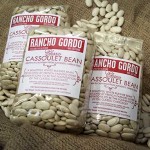 Is it marketing or is it history? Some would argue that a cassoulet isn’t a cassoulet without Tarbais beans. There are many more interesting arguments to be had but we think once you taste these, you’ll agree 100% that it’s a great bean and ideally suited to the slow cooked goodness of a cassoulet. All the various meats and seasonings mingle with the mild but sturdy beans and with a little effort, you have one of the classic dishes of soutwest France.
Is it marketing or is it history? Some would argue that a cassoulet isn’t a cassoulet without Tarbais beans. There are many more interesting arguments to be had but we think once you taste these, you’ll agree 100% that it’s a great bean and ideally suited to the slow cooked goodness of a cassoulet. All the various meats and seasonings mingle with the mild but sturdy beans and with a little effort, you have one of the classic dishes of soutwest France.
Rather than suffer French prices, which can run up to $30 a pound when out of season, we took seed from France and produced this bean with our distinct terroir here in California. Tarbais beans were developed by generations of farmers in Tarbais, France. The orginal seed is a New World runner bean (Phaseolus coccineus) and most likely orginated in Mexico. Out of respect for the French farmers and terroir, we’re calling the bean Cassoulet Bean. We think in order to call it Tarbais, it should be grown in southwestern France.
We’re incredibly excited to introduce you to these beans. Of all the beans we get requests for, it seems shoppers and cooks are most frustrated by the lack of Tarbais.
You can follow the classic rules (and we recommend Paula Wolfert’s glorious The Cooking of Southwest France : Recipes from France’s Magnificent Rustic Cuisine) or you can experiment and be creative. A casserole of cassoulet beans with odds and ends from your refrigerator and larder, topped with good bread crumbs and dotted with butter before a trip to the oven would be a welcome dish on a winter’s table.
From baked beans, to salads, to soups, there’s hardly a dish that couldn’t benefit from these beans. They have a thin skin but still manage to hold their shape making them ideal for salads. A simple bowl with roasted tomatoes and garlic would be incredible.